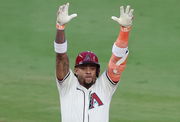

Baseball often feels timeless, a beautiful game built on familiar rhythms. But occasionally, small adjustments can send shockwaves through the game, shifting its balance. Now, a change is under consideration in Japan—one that originated across the Pacific and could redefine plays at every base. It’s a difference measured in only inches, but it could prompt a significant evolution in Nippon Professional Baseball (NPB).
Watch What’s Trending Now!
This discussion was inspired by a move made by Major League Baseball in advance of its 2023 season. The league decided to increase the size of first, second, and third bases. They expanded the bases from the original 15-inch-square size to a larger, 18-inch-square size. Officials said player safety was the primary reason, providing more space to avoid collisions, particularly around first base. A secondary aim was to boost action by slightly shortening base paths just a bit: the distances between first and second base, and between second and third base, were reduced by 4.5 inches.
This change came in addition to other modifications, including the pitch timer, which added a new element to the game. And now NPB leadership is actually, officially considering the exact same base-enlarging idea. The news was confirmed by Nippon Professional Baseball Organization Secretary-General Katsuhiko Nakamura.
ADVERTISEMENT
“We would like to try it out in the farm team once,” Nakamura stated. He emphasized a careful approach: “We will verify it and then decide what to do after receiving various opinions (from each team). We will discuss it again.” This signals a serious look at adopting the 18-inch standard, moving away from the current 15-inch bases.
The path forward involves careful testing before any league-wide decision. Nakamura described the specific plans for these trials. NPB plans to test out prototype larger bases within its farm system, likely starting soon. “Try using a prototype in Phoenix or somewhere,” he suggested, pointing to the upcoming Miyazaki Phoenix League. The fall developmental league, which is played from October 6 to October 27, typically serves as NPB’s testing ground. Feedback from players, like those from the Giants and Hanshin Tigers who briefly tried them in March, was reportedly “not bad,” adding momentum to these trials.
ADVERTISEMENT
NPB’s unique context
When considering MLB’s 2023 data, there are powerful reasons for motivation for NPB. The introduction of larger bases, coupled with the pitch clock, ignited baserunning. Successful stolen bases reached approximately 3,500, a number barely touched in the past several decades. More importantly, the success rate shot up to 80 percent, about five points higher than it had been the previous year. The pitch clock was a big part of it, undoubtedly, but the short distance made stealing just a little bit easier, and tempting for runners weighing the risk.
Beyond the exciting offensive boost, MLB’s primary safety goal also showed promising signs. Data gathered during Minor League Baseball testing was especially convincing for supporters of the change. Those leagues that used the wider 18-inch bases experienced a significant 13% reduction in injuries in and around the base compared to the previous season. This particular set of safety data from MLB provides NPB a concrete reason to seriously consider the change for its own players’ well-being.
ADVERTISEMENT
However, adopting larger bases isn’t without potential hurdles for Japanese baseball. The expense of replacing equipment in all NPB stadiums (including farm team facilities) also cannot be ignored. There might also be pushback from traditionalists attached to the familiar dimensions and appearance of the field. In addition, NPB operates in a lower-scoring environment, often called a “deadball era.“
Top Stories
Blue Jays Forced to Make Heartbreaking Trades as Ketel Marte Chase Triggers Bold D-Backs Demand: MLB Rumors

Shohei Ohtani Fear Fades as 36-Year-Old Teammate Terrifies MLB Managers Amid Rising Dodgers Dominance

“We’re the Pittsburgh Pirates”- Mets Radio Host Criticizes Steve Cohen for Duping Queens Fans After Dismantling the Core

ESPN Insider Loses Faith in David Stearns After Pete Alonso- Jorge Polanco “Headscratcher” Leaves Juan Soto & Mets Vulnerable

Blue Jays Handed Blunt Reality Check on Offseason Plans as Kyle Tucker–Bo Bichette Chase Heats Up

Ultimately, NPB stands at a crossroads, weighing tradition against the needs of future generations. The league has a tradition of adopting MLB rules, including the designated hitter in the Pacific League, while maintaining unique elements such as tie games after 12 innings. This shows a willingness to adapt, but also a commitment to its own identity. The next test will be in the farm league, and that is important. Will these larger bases usher in a new era of action and safety in Japanese baseball? Fans will be watching closely. What impact do you think larger bases would have on the NPB game?
ADVERTISEMENT
ADVERTISEMENT
ADVERTISEMENT
ADVERTISEMENT

